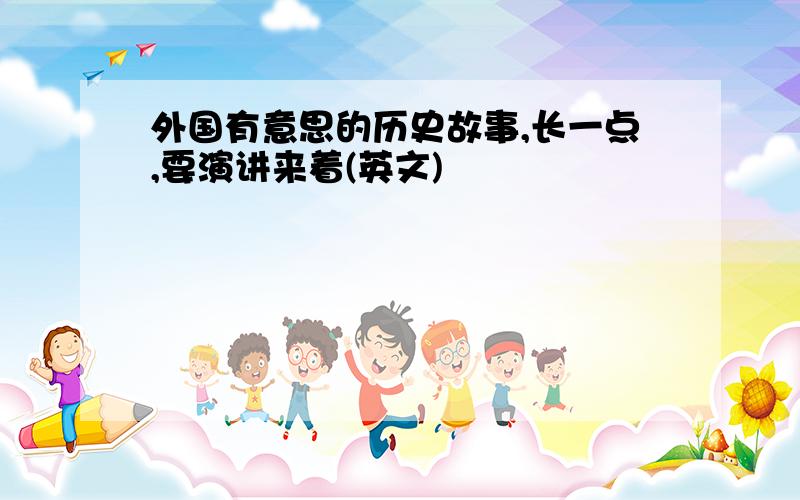外国有意思的历史故事,长一点,要演讲来着(英文)
来源:学生作业帮助网 编辑:作业帮 时间:2024/04/27 07:39:17

外国有意思的历史故事,长一点,要演讲来着(英文)
外国有意思的历史故事,长一点,要演讲来着(英文)
外国有意思的历史故事,长一点,要演讲来着(英文)
MY MOTHER fought cancer for almost a decade and died at 56. She held out
long enough to meet the first of her grandchildren and to hold them in her arms.
But my other children will never have the chance to know her and experience how
loving and gracious she was.
We often speak of "Mommy's mommy," and I find myself trying to explain the
illness that took her away from us. They have asked if the same could happen to
me. I have always told them not to worry, but the truth is I carry a "faulty"
gene, BRCA1, which sharply increases my risk of developing breast cancer and
ovarian cancer.
My doctors estimated that I had an 87 percent risk of breast cancer and a
50 percent risk of ovarian cancer, although the risk is different in the case of
each woman.
Only a fraction of breast cancers result from an inherited gene mutation.
Those with a defect in BRCA1 have a 65 percent risk of getting it, on
average.
Once I knew that this was my reality, I decided to be proactive and to
minimize the risk as much I could. I made a decision to have a preventive double
mastectomy(乳房切除术). I started with the breasts, as my risk of
breast cancer is higher than my risk of ovarian cancer, and the surgery is more
complex.
On April 27, I finished the three months of medical procedures that the
mastectomies involved. During that time I have been able to keep this private
and to carry on with my work.
But I am writing about it now because I hope that other women can benefit
from my experience. Cancer is still a word that strikes fear into people's
hearts, producing a deep sense of powerlessness. But today it is possible to
find out through a blood test whether you are highly susceptible to breast and
ovarian cancer, and then take action.
My own process began on Feb. 2 with a procedure known as a
"nipple(乳头) delay," which rules out disease in the breast ducts
behind the nipple and draws extra blood flow to the area. This causes some pain
and a lot of bruising, but it increases the chance of saving the nipple.
Two weeks later I had the major surgery, where the breast tissue is removed
and temporary fillers are put in place. The operation can take eight hours. You
wake up with drain tubes and expanders in your breasts. It does feel like a
scene out of a science-fiction film. But days after surgery you can be back to a
normal life.
Nine weeks later, the final surgery is completed with the reconstruction of
the breasts with an implant. There have been many advances in this procedure in
the last few years, and the results can be beautiful.
I wanted to write this to tell other women that the decision to have a
mastectomy was not easy. But it is one I am very happy that I made. My chances
of developing breast cancer have dropped from 87 percent to under 5 percent. I
can tell my children that they don't need to fear they will lose me to breast
cancer.
It is reassuring that they see nothing that makes them uncomfortable. They
can see my small scars and that's it. Everything else is just Mommy, the same as
she always was. And they know that I love them and will do anything to be with
them as long as I can. On a personal note, I do not feel any less of a woman. I
feel empowered that I made a strong choice that in no way diminishes my
femininity.
I am fortunate to have a partner, Brad Pitt, who is so loving and
supportive. So to anyone who has a wife or girlfriend going through this, know
that you are a very important part of the transition. Brad was at the Pink Lotus
Breast Center, where I was treated, for every minute of the surgeries. We
managed to find moments to laugh together. We knew this was the right thing to
do for our family and that it would bring us closer. And it has.
For any woman reading this, I hope it helps you to know you have options. I
want to encourage every woman, especially if you have a family history of breast
or ovarian cancer, to seek out the information and medical experts who can help
you through this aspect of your life, and to make your own informed
choices.
I acknowledge that there are many wonderful holistic doctors working on
alternatives to surgery. My own regimen will be posted in due course on the Web
site of the Pink Lotus Breast Center. I hope that this will be helpful to other
women.
Breast cancer alone kills some 458,000 people each year, according to the
World Health Organization, mainly in low- and middle-income countries. It has
got to be a priority to ensure that more women can access gene testing and
lifesaving preventive treatment, whatever their means and background, wherever
they live. The cost of testing for BRCA1 and BRCA2, at more than $3,000 in the
United States, remains an obstacle for many women.
I choose not to keep my story private because there are many women who do
not know that they might be living under the shadow of cancer. It is my hope
that they, too, will be able to get gene tested, and that if they have a high
risk they, too, will know that they have strong options.
Life comes with many challenges. The ones that should not scare us are the
ones we can take on and take control of.